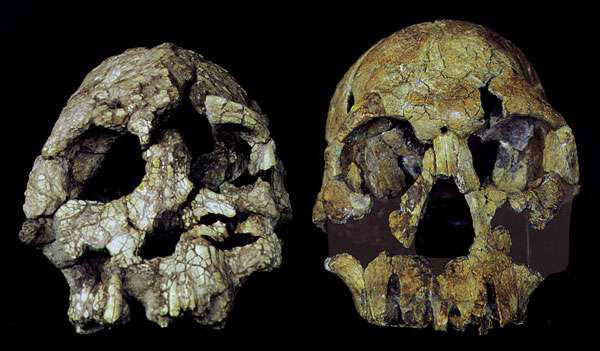
The announcement by a team of U.S., Ethiopian and international scientists of the results of their study of the fossil remains of the hominid Ardipithecus ramidus, a likely human ancestor from the Middle Awash region in Northern Ethiopia, fills in some important gaps in the scientific record of human evolution.
The existence of Ardipithecus, who lived some 4 ½ million years ago as a predecessor of Australopithecus (the genus which includes the famous “Lucy”), has been known since 1992, from minimal, fragmentary remains. The new reports are based on a much larger and more complete collection of remains, now totaling about 110 individuals, including a nearly complete skull with most of its teeth. The reports also summarize the analysis of the geology, botany and zoology of the place in which they lived.
What is new is that the remains, analyzed by Yohannes Haile-Selassie, Bernawe Asfaw, Yonas Beyene, Gilday Wolde-Gabriel, Tim White, Gen Suwa, C. Owen Lovejoy and a large interdisciplinary team, are not more similar than are those of Australopithecus to modern day chimpanzees, bonobos and gorillas. For example, the canine teeth, so large in chimpanzees, are much smaller in both Ardipithecus, Australopithecus and modern humans. This strongly suggests that the big canines of the modern apes are not an ancient survival which direct human ancestors lost over millions of years, but rather a new feature which evolved in response to specific environmental conditions.
So the common ancestor of chimps and humans did not start out with huge fang-like canine teeth like those of male chimps today. We humans have retained those small canines, while the size of the canines of chimp ancestors probably increased over the millennia. This has also lead to the markedly prognathous (sticking-out) lower face of the chimpanzee. This feature was not so pronounced in Ardipithecus, and even less in a possible Ardipithecus ancestor, Sahelanthropus tschadensis, from 6 to 7 million years ago, which was almost as vertical-faced as modern humans.
While our ancestors were evolving in a specifically human direction, chimp ancestors were not frozen in time, but were also evolving in a specifically chimp direction. While humans were becoming more human, apes were becoming more ape.
Evolutionary biologists since Darwin have always said that apes and humans derived from a common ancestor. But in the popular imagination, this was changed into “humans descended from apes.” The new discoveries may help to correct this.
There is also the question of descent from the trees and upright posture. It is clear from the new reports that Ardipithecus was capable both of tree climbing and of upright walking, though it was not as comfortable in the latter as modern humans are. Also, the analysis of the botany of the area shows that at the time, there was much more tree cover than there is today. Our ancestors were already “down from the trees” and walking on two feet before the trees disappeared. This suggests that the distinctive “knuckle-walking” of chimps, bonobos and gorillas is also a specific adaptation in their evolutionary line, rather than something our ancestors formerly did.
What is the significance of all this for understanding human nature?
Big fangs in chimpanzees are used in eating, but also in fighting other males over females, and in fighting other groups of chimps over territory. One theory has been that the smaller canine teeth of Australopithecus were an adaptation to the huge growth in that creature’s molars, itself an adaptation to eating fibrous foods. It was thought that the canines got smaller as the back teeth got bigger-a question of space. But the loss of the function of big canines in fighting seems a more likely explanation. As hominids became more oriented to cooperative life in social groups, the need for the big canines decreased, and they shrank.
The upright posture of Ardipithecus, and the specific anatomy of its hands suggest that they may have been able to manipulate objects as tools for a long while, though there is no sign so far that they were actually making tools. But the potential already existed with Ardipithecus. Modern ape hands are different, specifically adapted to grasping tree branches.
These studies validate the idea that human beings became what we are through a process of increased socialization of human activities, i.e. of more and more social cooperation. Brain size followed this, with Ardipithecus having a brain volume of about 300-350 cubic centimeters (comparable to a chimp) and modern humans averaging 1350 cubic centimeters.
The Zulu people of Southern Africa have a phrase: “Umuntu ngumuntu ngabantu.” “A person becomes a person in relationship to people.” These new paleoanthropological findings reinforce this wise position, so different from modern bourgeois ideology of individualism and competition.
The results of the new study are published in Science Magazine, and can be accessed at sciencemagazine.org.









